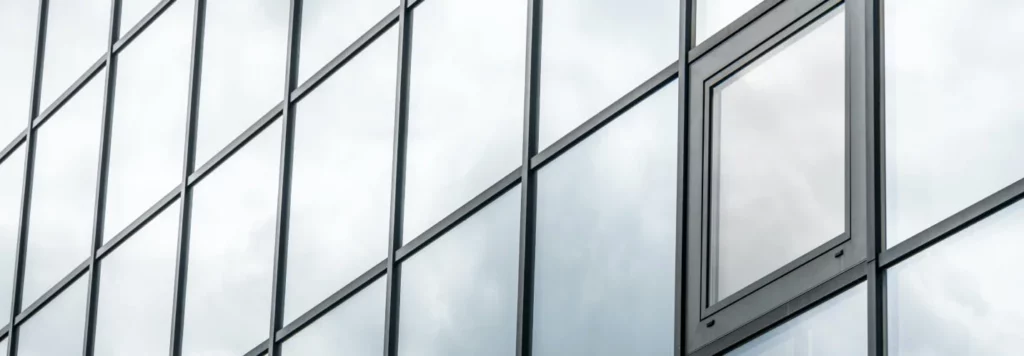EDUCATION
WIRED GLASS IN SCHOOLS: A 2023 UPDATE

It’s been two decades since the 2003 version of the IBC essentially banned the use of traditional wired glass in doors, sidelites and hazardous locations in schools and educational facilities – and yet, there are still a lot of questions about wired glass – questions like what it is, what it’s not, what the codes say, what alternatives exist, and so on.
What is Wired Glass – and What It’s Not
Wired glass is a type of fire rated glass, and most likely the oldest type of fire rated glass there is. The wires are there to keep the glass in place in the event of a fire. Its often mistaken for safety or even security glass because the wires gave the illusion of strength or impact resistance – when in fact, the opposite is true. The wire actually weakens the glass, making it half as strong as annealed glass. It breaks easily on human impact, exposing razor sharp wires that can trap a victim’s limb in the opening and increase the severity of the injury.

Understanding the Code Change
Back in 1977, the Consumer Product Safety Commission, or CPSC, established a federal safety glazing standard to protect people from injuries caused by accidental impact with glass. The building codes applied the CPSC standard to glass used in doors, sidelites and hazardous locations. Smaller glazing panels up to 1,296 sq. in. had to meet CPSC Cat. I, which is 150 ft. lbs of impact resistance. Larger glazing panels must meet CPSC Cat. II, which is 400 ft. lbs. of impact resistance.
When the CPSC standards were enacted, wired glass manufacturers were granted a temporary exemption and only had to meet 100 ft. lbs. of impact resistance. However, independent testing revealed that wired glass fails with as little as 50 ft. lbs. of impact resistance – a force that can easily be created by a 5-year old pushing on the glass. This where Bill O’Keeffe, President and CEO of SAFTI FIRST, In the 2003 version of the International Building Code, or IBC, wired glass lost its exemption from meeting CPSC safety glazing requirements in new schools and educational facilities. In the 2006 version of the IBC, wired glass lost its exemption in all new construction and in all types of occupancies.
Today, wired glass can no longer be used in doors, sidelites or any other hazardous location. Any replacement for broken wired glass in existing facilities must also meet the CPSC safety glazing standards. This monumental change in the building code still exists today, and has helped create safer schools for our children.

Are Schools Required to Replace Existing Wired Glass?
The code change only applies to new construction. Technically speaking, unless the wired glass is broken or compromised, the code does not require it to be replaced. However, this does not exempt schools from liabilities stemming from wired glass injuries.
In June 2013, the Kent Washington Unified School District settled a lawsuit stemming from a student injured by falling into an unsafe, traditional wired glass opening. In the end, the school district paid out 2 million dollars and issued an apology. Unfortunately, the Kent school district is not the first, and won’t be the last, school district to face consequences for exposing students to the risk of injury from wired glass.
In his article A Time Bomb in Our Schools, Kenneth Lumb writes: “In deciding what a reasonably careful school district should or should not do, the law will charge the school district employees with knowledge of the dangers of wired glass even if they are unaware of those dangers. A property owner must act reasonably in light of what it knew or should have known. It is virtually impossible today to plausibly claim ignorance of the dangers of wired glass in impact areas in light of the information available on the internet, in trade publications, and other sources, not to mention the number of injuries and six and seven figure verdicts and settlements that have resulted from those injuries. The fact that wired glass is allowed in an existing building because the code does not require its removal is not a defense to a negligence lawsuit.” Mr. Lumb is a Chicago Trial Lawyer at Corboy and Demetrio and has represented numerous victims of traditional wired glass, including the family of a 20-year-old college student who died after falling out of a hallway window glazed with traditional wired glass.
How Can Schools Protect Students from Wired Glass Injuries and Avoid Liabilities?
With majority of schools today built prior to 2003, the potential to be injured from accidental impact with wired glass still poses a real threat to many school children. School administrators and facility managers can take a proactive approach by replacing the unsafe wired glass in their buildings. Today, their choices include filmed wired glass, filmed ceramics, laminated ceramics and new, patented products called SuperClear 45-HS and SuperClear 45-HS-LI from SAFTI FIRST.
Of these options, the SuperClear products from SAFTI FIRST are the only products made in the USA, and the only products that can meet fire, hose stream and safety requirements without wires, tints, films or laminates.
The SuperClear products are the most durable, which is an important consideration in schools. To demonstrate this, here’s how these products performed in the same, CPSC Category II impact test.
In addition to durability, the SuperClear products offer superior sound attenuation, which makes it ideal for schools.
Because the SuperClear products are made in the USA, it is readily available at an affordable price. It can be used in standard hollow metal doors and frames or with any SAFTI FIRST fire rated doors or framing.
The SuperClear products can be customized to provide additional protection against bullets, forced entry, vandalism, blast or any other threat. Decorative and energy efficient make-ups are also available.
If you are ready to upgrade your school to the best, most affordable and only USA-made clear fire rated glazing available, give us a call at 888.653.3333 and our representatives are ready to help you. You can also send an email to info@safti.com or visit us online at safti.com.